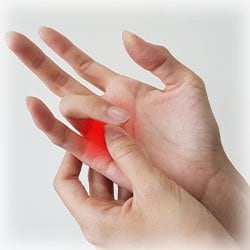What Is Trigger Finger and How Do You Fix It?
 What is Trigger Finger?
What is Trigger Finger?
If one of your fingers feels like it clicks, catches or locks when you straighten and bend it, you may have a condition known as trigger finger. This common condition may have a funny name, but it is very well-suited to the problem because it can cause your finger to get stuck in a position that looks like you’re squeezing a trigger.
The clinical term for trigger finger according to Alexander Mendez MD, is stenosing tenosynovitis and it can affect any one of your fingers, including your thumb. When it affects the thumb, it is often referred to as trigger thumb. But no matter which finger is affected, the symptoms and treatment are the same.
What Causes Trigger Finger?
The most common symptoms of trigger finger include stiffness and a catching or locking sensation when you bend or straighten your finger. This may be accompanied by pain. You may also have a small tender lump at the base of the affected finger near the palm, due to inflammation of the flexor tendon. After the finger catches in a bent position, it may suddenly pop straight. In more severe cases, you may be unable to straighten your finger. Symptoms may be more noticeable after you have not moved your fingers in a while, such as when you wake up in the morning.
What are Trigger Finger Risk Factors?
Although the exact causes of trigger finger are not known, it may be more likely to occur after a period of repeated gripping or forceful use of the fingers or thumb. Other factors that may increase your risk of developing the condition include:
- Being female
- Having diabetes or rheumatoid arthritis
- Undergoing previous surgery for carpal tunnel syndrome
Does Trigger Finger Have a Treatment?
If you have symptoms of trigger finger, and conservative treatments such as rest, gentle stretching or taking over-the-counter nonsteroidal anti-inflammatory drugs (NSAIDs) such as Advil, Motrin or Aleve, don’t help, it may be time to see a doctor. Treatments that may be recommended for trigger finger include:
- Steroid injections – This is the most common treatment and involves a medical professional injecting a steroid medication into the area of inflammation at the base of the affected finger so the tendon glides more freely. You may need more than one injection for it to be effective.
- Percutaneous release – If steroid injections don’t help, a doctor may perform a procedure in which a needle is inserted into the tissue around the affected tendon to break apart the constriction that is stopping the tendon from moving freely. Your palm will be numbed during the procedure and ultrasound may be used to guide the movement of the needle.
- Surgery – This involves a surgeon making a small incision near the base of the affected finger to open up the constricted area where the tendon is getting stuck.
If you have trigger finger symptoms, you should make an appointment with your primary care physician. Learn about our Family Medicine services and family medicine physicians at PIHHealth.org.
Copyright 2022 © Baldwin Publishing, Inc. All rights reserved. Health eCooking® is a registered trademark of Baldwin Publishing, Inc. Cook eKitchen™ is a designated trademark of Baldwin Publishing, Inc. Any duplication or distribution of the information contained herein without the express approval of Baldwin Publishing, Inc. is strictly prohibited.